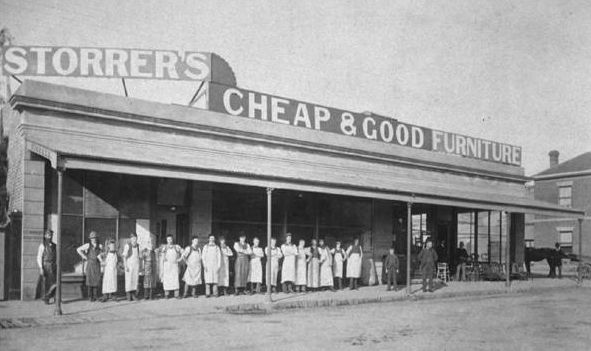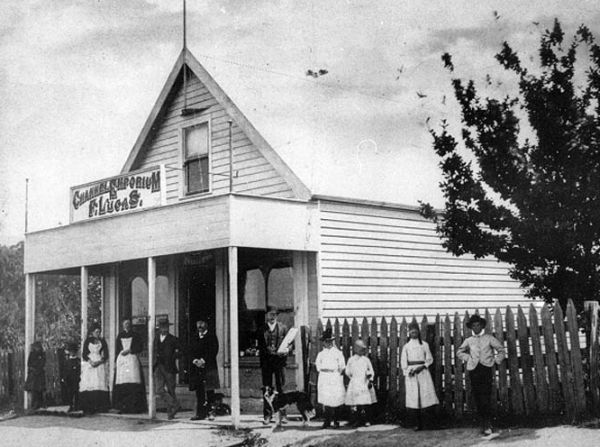 |
 |
|
Shops
Shops began in Tasmania in the earliest settlements, with people selling their own products and a range of imports from England. In about 1806 Maria Riseley (later Lord) opened one of the first shops in Hobart to sell goods she brought from Sydney, including maize, tea and spirits. Shopkeepers sold a wide range of goods, and with supplies erratic, prices varied according to stock available. Gradually supplies became more regular, and specialised shops appeared, such as butcheries and bakeries; in the 1820s some successful shops, such as Hopkins' ironmongery, grew large. As towns developed, all had a general store, and other shops according to the size of the population. Different types of shop appeared in the 1830s and 1840s, such as bookshops (J Walch and Co) and clothing stores. Itinerant pedlars sold items such as sewing and kitchen supplies, some until the Second World War; the 'Rawleigh's man' was still selling goods around Hobart in the 1960s. In the second half of the nineteenth century, enterprising individuals founded large department stores in Hobart and Launceston, selling many different sorts of merchandise, some developing from smaller original shops. FitzGeralds, Brownells, McKinlays and Medhursts all flourished, sometimes with branches in country towns. Coogans and Charles Davis manufactured much of their merchandise, furniture and ironmongery respectively. Hobart and Launceston had a range of shops, with competing window displays and fancy decorations on occasions such as coronations. Most were family businesses, many like Soundys owned by several generations of the family. Large shopkeepers were community notables, serving on the local council and often in parliament. Small specialist shops and general stores continued, and in suburbs, lack of transport and refrigeration meant that every few blocks saw a corner shop, selling groceries and perishable goods. In large country towns, some individual shops grew large, such the River Don Trading Company at the Don River and Devonport, with branches in nearby towns; Stride's stores in the Huon; Wells' Store (1893) in Latrobe; Slater's Country Store (c 1900) in Sheffield; and HE Thomas in Penguin (1909).
In the 1920s and 1930s, mass production of cheaper goods fostered the growth of chain stores, such as Coles. (Tasmania has a connection here: George Coles bought the general store in Wilmot in 1912, and his son George James Coles began the chain in Melbourne in 1914.) Chains such as Myer and Coles moved into Tasmania, and in the 1950s refrigeration and increasing mechanisation led to the appearance of supermarkets, with Dutch migrants Engel Sypkes in the south and Roelf Vos in the north prominent. As cars multiplied in the 1960s and 1970s, suburban shopping centres grew, many corner shops disappeared, and inner city shops suffered. Many established stores, often asset-rich but cash-strapped, disappeared in mergers and takeovers, and more national stores like Woolworths moved in, taking over many local businesses such as the Vos and Sypkes ('Purity') chains. Sypkes moved on to found another chain, Chickenfeed bargain stores. Years of argument over shop trading hours seemingly ended in 2002 when all shops could open seven days a week. Many small shops closed, but shopping was more convenient. Some nineteenth-century shops still trade, notably Wells' at Latrobe, Slater's in Sheffield, Thomas's in Penguin, and Coogans, now in Hobart. Further reading: A Dyer, Buttons, bodices & britches, Sheffield, [2000]; A Alexander, Charles Davis, Melbourne, 1998. Alison Alexander |
Copyright 2006, Centre for Tasmanian Historical Studies |

